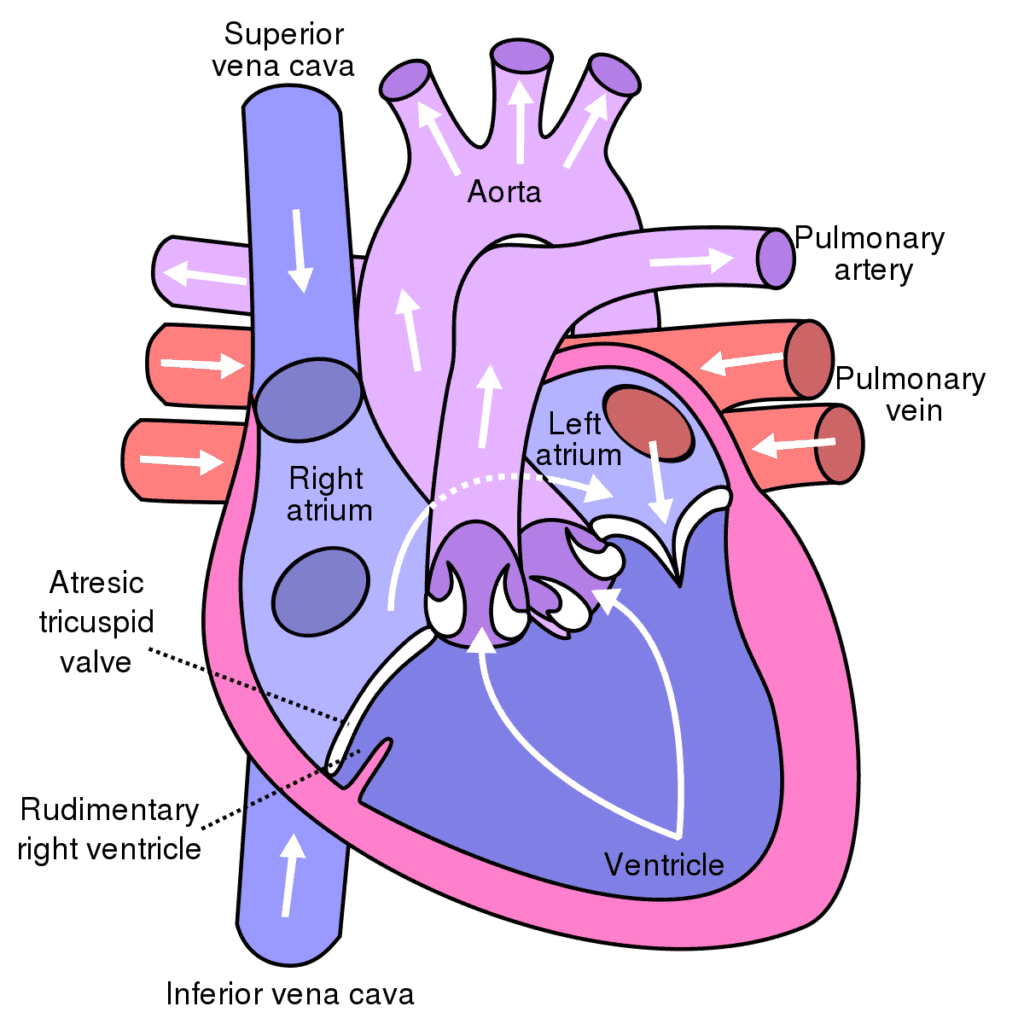Tricuspid atresia is a congenital malformation of the tricuspid valve, which regulates blood flow from the right atrium (upper right chamber of the heart) to the right ventricle (lower right chamber of the heart). Tricuspid atresia occurs when this valve fails to develop, preventing the flow of oxygenated blood from the right atrium to the right ventricle and lungs. Because a kid with tricuspid atresia may require surgery or other operations shortly after birth, this congenital heart condition is regarded as serious. Congenital refers to existing at birth. Tricuspid atresia prevents an infant, child, or adult from receiving adequate oxygen throughout the body. This illness is characterized by rapid fatigue, shortness of breath, and blue-tinged skin.
Tricuspid atresia symptoms appear shortly after birth and may include:
- Skin and lips have a bluish hue (cyanosis)
- Difficulty in respiration
- Exhausted quickly, particularly during feedings
- Sluggish growth and inadequate weight gain
Some infants and adults with tricuspid atresia develop heart failure symptoms, including:
- Fatigue and frailty
- Problems breathing
- Swelling of the legs, ankles, and feet (edema)
- Abdominal swollenness (ascites)
- Spontaneous weight increase due to fluid retention

Diagnosis
A cardiac murmur may or may not be present in infants with tricuspid atresia. A device called a pulse oximeter can simply and painlessly monitor the quantity of oxygen in the blood.
The symptoms mentioned by the parents and the physical examination of the kid will urge the physician to conduct more tests to assess the heart.
Echocardiography can reliably detect tricuspid atresia and the related particular issues, such as ventricular septal defect and transposition of the great arteries. This includes the use of ultrasound equipment to produce images of the heart and to display the direction and, in some situations, the volume of blood flow via specific heart and blood artery regions.
Additionally, a chest X-ray and electrocardiogram (EKG) are frequently done.
Types of Tricuspid Atresia
Cases of tricuspid atresia are classified by healthcare professionals into distinct groups. Up to 80% of the population has Type I diabetes. Types I and II additionally have three subgroups dependent on the presence of other cardiac abnormalities.
Type I: The pulmonary artery and aorta (or “great arteries”) of your infant are in the right position. However, they may have a ventricular septal defect or an issue with their pulmonary valve.
Type II: The pulmonary artery and aorta of your baby are switched. In addition, there is a ventricular septal defect and probably an issue with the pulmonary valve of your child.
Type III (the rarest type): The location of your baby’s pulmonary artery, aorta, and right and left ventricles may cause complications.
Treatment
Your infant will be hospitalized to the Evelyn and Daniel M. Tabas Cardiac Intensive Care Unit (CICU), where he will receive 24-hour care from a team of cardiac critical care medicine specialists. Your infant may need oxygen and a drug called prostaglandin to maintain an acceptable blood oxygen level. Intravenous prostaglandin maintains the link between the pulmonary artery (the artery that transports blue blood to the lungs to receive oxygen) and the aorta (the artery that carries red blood to the body).
This link, known as PDA or patent ductus arteriosus, is present in fetuses and closes shortly after birth. When the PDA shuts, some infants with tricuspid atresia become very cyanosed. Prostaglandin infusion can reopen the PDA and is a lifesaving intervention. Not all infants with tricuspid atresia need prostaglandin treatment.
If your infant has laborious or ineffective breathing, he or she may require a breathing machine or ventilator. It is fairly unusual for infants receiving a prostaglandin infusion to have low respiratory effort or apnea.
At least two, and potentially three, surgical procedures will be necessary:
Blalock-Taussig
Babies that need prostaglandin to maintain an acceptable quantity of oxygen will require surgery shortly after birth. The procedure entails the development of a “shunt,” which is a tube that joins one of the aortic branches to the pulmonary artery, therefore replacing the PDA. This process is known as the Blalock-Taussig or BT shunt. Many infants with tricuspid atresia are well enough to go home shortly after delivery. Nonetheless, some of these infants may require the “shunt” procedure a few weeks after birth if their blood oxygen level is falling.
Some infants with tricuspid atresia will need a surgery termed “pulmonary artery banding” to constrict the pulmonary artery and control blood flow to the lungs. If the aorta is too tiny, infants with tricuspid atresia and transposition of the major arteries may require the “Norwood procedure” (see hypoplastic left heart syndrome).
Hemi-Fontan/Glenn
The second procedure, known as the hemi-Fontan/Glenn surgery, often takes place within six months after birth. During this procedure, the superior vena cava — the major vein related to the heart that returns deoxygenated or blue blood from the upper portion of the body — is severed or detached from the heart and joined to the pulmonary artery. During this procedure, the BT shunt is also closed by the surgeon. After the treatment, deoxygenated or blue blood from the upper body bypasses the heart and travels directly to the lungs.
Fontan
The third procedure, known as the Fontan, is performed between the ages of 1 1/2 and 3 years. During this procedure, blood is redirected straight from the inferior vena cava to the pulmonary artery. The inferior vena cava is a big vein that sends deoxygenated blood to the heart from the lower part of the body. This implies that deoxygenated or blue blood from the entire body travels directly to the lungs, bypassing the heart.
After these procedures, deoxygenated blood goes directly to the lungs, bypassing the right side of the heart. Based on your child’s heart structure, the Cardiac Center experts will provide a more thorough explanation of the surgical treatments.
Historically significant, the Fontan procedure was initially done on individuals with tricuspid atresia.
Prognosis
The majority of unoperated patients die during the first year of life. In the modern era of earlier diagnosis and excellent surgical treatment, the majority of patients with TA have a fair functional ability and survive well into adulthood. The Fontan operation has a mortality rate below 2 percent. Sittiwangkul’s 2004 research is the most comprehensive examination of the outcomes of patients with TA (between 1971 and 1999), reporting survival rates of 82 percent, 72 percent, and 61 percent at 1, 5, and 20 years, respectively. Surgical outcomes have vastly improved throughout time as a result of adjustments to surgical procedures and innovations in patient care. More recent research by Mery et al. examining the results of patients who underwent the Fontan operation for various diseases (including TA) revealed that transplant-free survival after 15 years was 92% and Fontan failure-free survival was 87%.


